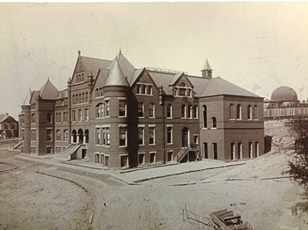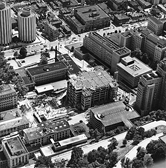By Kaitie DeOre
 Hugh Henry Brackenridge was granted a charter by state legislature to start the Pittsburgh Academy in 1787. It was originally housed in a log cabin downtown and moved to a two-story brick building in 1790. A recreation of the original log cabin stands on Forbes Avenue next to the Cathedral of Learning, which serves as a reminder of the university’s roots. The charter was amended in 1819 to transform the Pittsburgh Academy into the Western University of Pennsylvania, a sister institution to the University of Pennsylvania.
Hugh Henry Brackenridge was granted a charter by state legislature to start the Pittsburgh Academy in 1787. It was originally housed in a log cabin downtown and moved to a two-story brick building in 1790. A recreation of the original log cabin stands on Forbes Avenue next to the Cathedral of Learning, which serves as a reminder of the university’s roots. The charter was amended in 1819 to transform the Pittsburgh Academy into the Western University of Pennsylvania, a sister institution to the University of Pennsylvania.
The Great Fire of 1845 destroyed 20 blocks in downtown Pittsburgh, including all the university buildings, during which time Trinity Cathedral served as a temporary home for studies. In 1846, the first two engineering students graduated from the university, J.B. Stilley and Isaac Morley. After this, there was much debate as to the purpose of the university, if it were meant to be for classics or technical education. The debate was interrupted by another fire, until classes resumed in 1855.
 A four-year engineering degree was created in 1867 after Congress passed an act to install military officers at major universities to “maintain readiness in the event of another war.” After the installment, the university moved to a site adjacent to the Allegheny Observatory which it had taken over in 1865. There were 11 graduates including Stilley and Morley, and the first credited graduate in 1883 with a civil engineering degree was William Carey Coffin Jr.
A four-year engineering degree was created in 1867 after Congress passed an act to install military officers at major universities to “maintain readiness in the event of another war.” After the installment, the university moved to a site adjacent to the Allegheny Observatory which it had taken over in 1865. There were 11 graduates including Stilley and Morley, and the first credited graduate in 1883 with a civil engineering degree was William Carey Coffin Jr.
The Western University of Pennsylvania became the University of Pittsburgh in 1908, after moving to Oakland the previous year. That year the student body consisted of 34 students in the School of Mines, 102 in Engineering, 99 in Arts and Sciences, and 863 in the four professional schools (Law, Medicine, Dentistry, and Pharmacy). The Co-Op program started in 1910, which was the second in the country, was a program that allowed students to gain a year’s worth of industry experience prior to graduation. The program was suspended in the 1930s but was reinstated in 1987 and has prospered since as a university staple.
During World War I, the university lead a training camp, Camp Hamilton, which provided ten weeks of military and engineering training for civil, sanitary, mechanical, electrical, and railway mechanical engineering students. Classes were also modified to include military training. As of October 1,1918, there were 1,351 students who completed training as a member of the Students’ Army Training Corps (SATC).
The Student Chapter of ASCE was initiated in 1918, concurrent with the organization of the Pittsburgh Section of the Society. The program was first accredited in 1936 by the Engineers Council for Professional Development as part of the first cohort of accredited programs. Other University of Pittsburgh (Pitt) programs accredited were Mechanical, Aeronautical, Electrical, Chemical, and Industrial Engineering.
During World War II, Pitt hosted a program that was designed to prepare civilians for technical assignments anticipated for war. They were non-credit courses that were offered in the evening, tuition free, and were on topics such as engineering drawing, surveying, and structural design. By the time the program concluded in 1944 nearly 25,000 men and women had been trained at Pitt. After the war, tuition skyrocketed with GI Bill recipients. In 1945, there were 592 engineering students; in 1948 there were 2,682 engineering students.
 After the GI Boom leveled off, and enrollment leveled off to graduate 30 students a year on average, the university elected to become a “state-related” institution. This provided the school with annual, non-preferred financial appropriations in exchange for offering tuition discounts to in-state students. The effects were immediately obvious, as graduates of Civil Engineering more than doubled in the 1970s. Graduate school enrollment at Pitt also soared during this time, as it ranked 12th nationally for the number of Master’s Degrees awarded as well as 21st in Ph.D. degrees conferred. Benedum Hall was built in 1971, which is still home to the school today.
After the GI Boom leveled off, and enrollment leveled off to graduate 30 students a year on average, the university elected to become a “state-related” institution. This provided the school with annual, non-preferred financial appropriations in exchange for offering tuition discounts to in-state students. The effects were immediately obvious, as graduates of Civil Engineering more than doubled in the 1970s. Graduate school enrollment at Pitt also soared during this time, as it ranked 12th nationally for the number of Master’s Degrees awarded as well as 21st in Ph.D. degrees conferred. Benedum Hall was built in 1971, which is still home to the school today.
The Civil Engineering Department established a Construction Management Program in the early 1990s, led by Alumnus Jack Mascaro and Dr. John Richards, at the urging of local construction firms. Today the program is led by John Sebastian. The Environmental Engineering program became a separate major recently, being accredited in 2016 as part of the push led by current Civil and Environmental Chair Dr. Radisav Vidic. The Mascaro Center for Sustainable Innovation was established in 2003 and has been a research power-house ever since, supporting both student summer research endeavors and year-round innovative research. Its faculty developed a University-wide certificate in sustainability and a MS degree in sustainable engineering.
The introduction of the concrete canoe competition took place in 1990, resulting in the start of their team for the 1991 races, a competition that still has strong roots at Pitt. Some recent awards that the Pitt Chapter has received include Distinguished Region II Chapter Award in 2013 and a Letter of Honorable Mention in 2014. Pitt took home Second Place Overall at the Ohio Valley Student Conference in 2015, and a Third Place Overall in 2016. During 2016, Pitt was also selected as one of two finalists for the Richard J. Scranton Outstanding Service Award.
They have also continued to progress their community outreach, partnering heavily with Pitt’s Chapter of the Society of Women Engineers. In March of 2019, Pitt’s Student Chapter hosted their first large-scale outreach event for high school students interested in Civil Engineering, an event sponsored by the Pittsburgh Section, Region II, and CEC. The University of Pittsburgh’s Student Chapter received Distinguished Region II Awards in 2016, 2017, and 2018. In addition, the chapter has been a Top Five Finalist for the Robert Ridgeway Award in both 2016 and 2017, an award given to the single most outstanding student chapter in the world. Pitt also received an Honorable Mention Chapter in 2019, as well as First Place Overall at OVSC, and also the Spirit Award.
Additionally, Pitt ASCE’s current president, Kaitie DeOre, was recently awarded the 2019 Region II Most Outstanding Student Member Award for her involvement with the chapter. To date, there have been 4,130 Civil Engineering Bachelor’s graduates, 1,449 Master’s graduates, and 234 Ph. D. graduates.
H2P!
